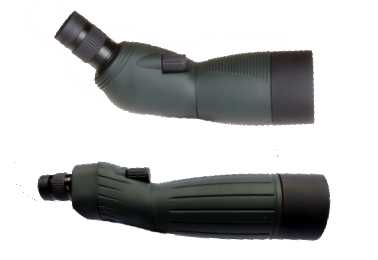There’s a lot of uses for a good spotting scope. They are one of the most powerful optics you can buy for use in the daytime. Any more power than a spotting scope and you’re into telescope territory.
In fact a good spotting scope will be designed to magnify distant objects up to a maximum of 80x which is more than is normally practically usable before all but the most perfect of atmospheric conditions get in the way.
They’re versatile bits of kit. Hunters use them, target shooters, bird watchers, snipers, surveillance experts, astronomers… you can mount them to a car window, on a tripod, rest them on the ground. I could go on, but you get the idea.
They’re versatile.
If you want to get the best scope for the job, you really need to be clear what that job is first. But before we get into the nitty gritty and in case you’re short on time here’s our shortlist broken down for each price range – low/mid/high.
Our Picks for the Best Spotting Scope
- Emarth 20-60x60m – The best spotting scope for the money – Compact, light and amazing value
- GoSky 20-60x – Great value scope with a good accessory pack
- Barska Blackhawk – Comes with a soft AND hard case
- Vortex Razor HD, 20-60x85mm – A lot of scope for the money
- Swarovski Spotting Scope – Unparalleled optical clarity all the way to 60x
Low End Scopes
Low/Mid Range Scopes
Mid/High Range Scopes
Note: Our individual reviews are below, but you can also click any of the links above to check current prices on Amazon and other retailers
If you’re looking for a scope for a particular use, or maybe you’re on a budget. If you don’t see exactly what you want here checkout our other guides:
- Budget Spotting Scopes
- Scopes for Target Shooters (all distances)
- Ideal Scopes for 100 yards (short range)
- Spotting Scope Tripod Roundup
Table of Contents
Spotting Scopes – A General Buyers Guide
Before we get to the review here’s our general buyers guide. This takes you through everything you’d need to know about spotters, specifications, features, extras, manufacturers, who needs what and more…
If you want a quick introduction to spotting scopes and prefer your video to the written word, take a look at this one from Optics Planet. That should get you started, but this article goes into far more detail on far more points than Trevor can in 7 minutes.
Specifications – The Numbers
Magnification Power and Objective Lenses
We’ve written an entire guide on what scope numbers mean. But here’s the basics…
A scope designated like this…
20-60x70mm
Is a zoom scope with 20 to 60 x magnification power and a 70mm objective lens. A bigger lens will give you more light transmission and a better picture in the dark. But don’t be suckered into thinking that a bigger lens means a better scope. Quality matters a lot when it comes to optics. A quality 60mm lens will give you a better picture than a cheap 80mm lens.
What power do you need for what use case? We’ve covered that later on in this article.
Field of View
The more you zoom in on something the smaller your field of view gets. Your field of view now (unless you have tunnel vision) is about 210° in a horizontal arc. Spotting scopes normally list a field of view parameter in their specifications. Whilst they’re never going to give you a 210° field of vision, this number does allow you to contrast one scope with another.
Field of view or FOV is normally listed as either ft @ 1000 yards or degrees @ 1000 yards. For example:
100-142 ft @ 1000 yards or 1.9-2.7 degrees @ 1000 yards
A higher field of view will make it easier to track and follow moving objects.
Eye Relief
The measurement of eye relief lets you know how far away from the scope your eye can be before you aren’t able to see all of that field of view. A lower power scope will have a larger eye relief than a larger one. If eye relief is really low on a scope you may have trouble using with with thick glasses or even shooting glasses.
For example a 16-17 mm eye relief listing on a scope means your eye needs to be at least 16 mm and can be up to 17 mm from the surface of the eyepiece lens to see all of the view.
Eye relief isn’t something you usually need to worry about unless you wear glasses. An eye relief of 16-17mm is fine for someone in specs. However if you have very thick glasses you may struggle to get your eye within the distance range the scopes eye relief and the image you see will be clipped.
Styles and Features
Angled or Straight?
Yep, there’s two types. A straight scope has the eyepiece in-line with the objective lens. An angled spotting scope has the eyepiece angled to the objective lens. Sometimes this angle is 90° but not often, normally it’s at 45°. An angled eyepiece can normally be rotated around the barrel of the scope, but not always. That rotation offers more versatility than a fixed angle. Angled vs straight spotting scopes are really the subject of an entire discussion itself, and it’s one we’ve covered already, if you’re interested, checkout that link!
Some scopes have the eyepiece in-line with the objective lens but set slightly higher. These are Porro Prism scopes. Porros are a little bulkier than a straight through roof prism scope but generally this method of manufacturing keeps the cost down.
What’s a Porro Prism?
You’ll probably come across this term when looking for scopes. Ignazio Porro invented this type of design and what it means simply is that the light from the objective lens goes through a ‘dog leg’ shape before reaching the eyepiece. This makes scopes shorter but slightly bulkier in general. You can identify Porro straight scopes and binoculars because the eyepiece points in the same direction as the lens but does not line up exactly. It sits higher or to the side, on a dog-leg.
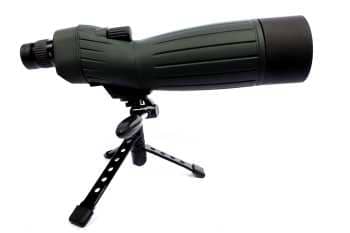
Porro prism scopes are cheaper and easier to manufacture than the roof prism and generally a cheap porro will beat a cheap roof prism for image quality. However roof prisms exist and manufacturers sell them because they are more compact optical systems.
Night Vision
Night vision scopes are a different beast entirely to spotting scopes. Spotting scopes are designed to be used in the day or dusk and have large object lenses to let-in as much light as possible. If you want to see at night you need to look specifically for a night vision scope, night vision binos or a night vision goggle. These types of kit are usually classed entirely on their own and will have much lower magnification ability than a general purpose spotter.
Spotting Scopes with Reticles
If you want to estimate range using a spotting scope, unless you have a rangefinder or a scope with a rangefinder built into it you’ll want something with a reticle with the MilDot or TMR (Tactial Milling Reticle) standard.
Sometimes this type of scope is listed as a ‘tactical’ scope.
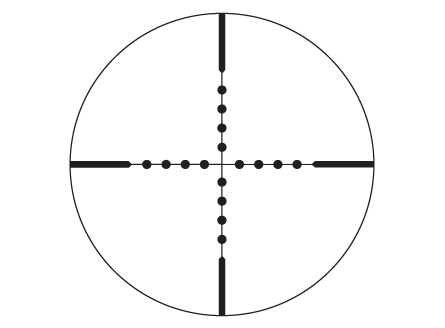
If you’re unsure exactly how or what MilDot or TMR are and how you’d use this type of reticle to estimate range then you’ll need to learn that first. Basically there are divisions marked in the reticle and you know what those represent, you also know how far you are zoomed in and you have to estimate the size of the object you are zoomed in on, then doing a bit of maths you can figure out the distance to a target. There are some great guides out there on the subject, like this one on the mil-dot.com website.
Spotters with Rangefinders
Most rangefinders are laser, and the finder works by understanding how long it takes to bounce a beam of light (a laser) off the target. If the target isn’t reflective, is a loooong way away or behind cover, brush, in a dustbowl etc they don’t work as well as a tactical scope would for range.
We’d guess that’s why tactical scopes exist.
We’ve not come across any spotting scopes with rangefinders built in. If anyone makes such a thing, it’s probably going to be very big and awkward.
You’re really better off getting the two things separately. But we’ve got you covered there, here’s our guide to budget,long range and bowhunting rangefinders.
Nitrogen / Argon Gas
Some scopes will come filled with Nitrogen or even Argon. If you fill the space in optical devices with these gases you prevent moisture and fog occurring inside the lenses. Some optics are ‘purged’ with nitrogen or argon to remove all the oxygen, then sealed to prevent te gas escaping. This gives them a permanent internal anti-fog coating.

The jury is out as to whether nitrogen or argon is actually the best gas to use. We’ve seen nothing compelling which sways us either way.
Externally things are a different matter and fogging of the outside of the glass comes down to…
Lens Coatings
Lens coatings are important and good coatings add to the cost of optics. When you shine light through a lens, or window or glass for that matter, some of that light transmission gets lost. The beam on the other side isn’t as bright.
The goal of a good optic is to get as much light as possible inside the lens to give you a bright and clear picture in the day and also helps in low light conditions. In order to help the natural properties of glass manufacturers coat their lenses with chemicals designed to increase the light passing through the lens.
Lenses can be Coated, Fully Coated, Multi-Coated or Fully Multi-Coated.
- A coated lens has a single layer of coating on at least one lens surface.
- Fully coated lenses have a single layer on all external surfaces exposed to air.
- Multi-coated lenses have multiple layers of coating on at least on lens surface.
- A fully multi-coated lens has… you guessed it… multiple layers of coating on all lens surfaces exposed to the air. This is the best type.
Waterproof Scopes
We mentioned earlier that scopes can be purged and filled with nitrogen to stop fogging and then sealed to prevent the gas escaping. Once the device is sealed like this manufacturers don’t have many more hoops to jump through to give the device a ‘waterproof’ label.
Waterproofing scopes is less about being able to drop them in the river and more about making them last for people people who want to use them in extreme weather conditions. Waterproof scopes are common and a good idea if you aren’t sure where you’re going to end up using one.
Armor
Because they’re used outside a lot, sometimes on the move, you can look for a scope with rubber armor to prevent damage from the odd bump and scrape. Armored scopes are the kind used by the military and certain types of hunter. It’s a nice feature to have.
A Little on Tripods & Window Mounts and Extras
Camera and cell-phone adapters – Digiscoping
You can use a spotting scope for digiscoping. Digiscoping means attaching your camera of cell-phone to the scope so that you can take good quality images of what the scope sees. Adapters are available for this purpose. Some are specific to the scope and some are universal.
Tripods & Car Window Mounts
Spotting scopes are high magnification devices. The more you magnify something the more you also magnify any movement in the lens. If you try and hold a spotting scope at anywhere near full magnification you’ll just see a very shaky image. That’s the reason they are normally mounted on a full size or tabletop tripod. A good tripod is sometimes supplied WITH a good scope, otherwise, unless you’re planning to always have somewhere steady to rest your scope, I’d look into getting one.
Car window mounts are also available for spotting scopes. As a spotting scope has the same mounting thread hole (1/4-20) as the camera and other optical devices the same window mounts you’ll see used for those devices can be used for your spotter.
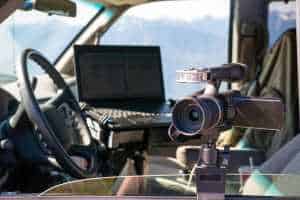
Window mounts make it easy to spot on the move. Car mounts are great for bird watching and other types of spotting like tornado chasing where you may need to move a long distance quickly using something other than your feet!
Skins
If most of your hunting setup is camo, why not the scope? They don’t all come with camo wrap because they have such a diverse range of uses not everyone wants it. But you can buy aftermarket skins for scopes, sleeves and covers that will swathe your scope in camo hiding it and you more easily.
What Scope Do I Need?
Well I’ll assume you know that you’re above the binocular and below the telescope in magnification power with a spotting scope. If you don’t then we’ve written a couple of articles on the subjects of binoculars vs spotting scopes and telescopes vs spotting scopes. Let’s take a look at the typical scope user and what they might want…
Hunters
Hunters use both binos and spotters. Binoculars to sweep and locate and spotters to zoom in, identify. Telescopes are unsuitable for hunting, too fragile, not portable, just not the right tool.
A hunter on the move will usually want a small, lightweight and portable scope that easily fits into a pack or case. These come with a reduced magnification level, but if you’re not intending to spot from long distances the 15-40x magnification range and the smaller sizes of objective lens (50mm) will provide what you need.
A more long range hunt with a base station, truck, tree-stand or hide where you can keep larger equipment will mean you’d probably go for a more powerful optic with higher magnification and a larger objective lens. So anything goes here. Weatherproofing, armor, these are the types of extra features you’ll be looking for.
Bird Watching
Birders use both spotters and binoculars. Depending on what you want to see, how far away it is, and whether you want to digiscope (use a camera on your scope) or not.
When it comes to scopes, birders are looking for detail and a clear image, so the best quality of optic is paramount. If you’re just looking in your backyard 15-40x magnification will suffice, but at longer ranges 20-60x with a larger objective lens becomes more appropriate.
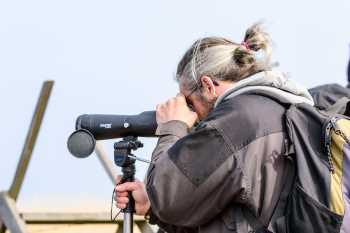
Size of scope and features really depends on exactly how you will be using the scope.
Astronomers
You can use a spotting scope for astronomy. 60x is good enough to view the moons of Jupiter on a clear day. Whilst telescopes go much higher into the magnification power spectrum a good spotting scope can be used for basic astronomy AND other things.
To use a spotter for astronomy you want a high magnification range.
Target Shooters
A sniper will use a spotting scope to range and track a target from distance and competitive shooters use them in their setup to see the target and the effectiveness of their shooting. Archers use spotters at the range to see whether a scoring ring has been broken or not without entering the range on shots of up to Olympic distance of 76.5 yards.
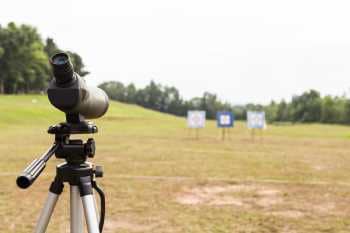
You’ll see shooters set up in competitions with spotting scopes alongside their rifle. They’ll shoot, then switch to the scope with a small move of the head to take a closer look at the result.
These types of applications don’t usually need lightweight portable scopes because they’re in a fixed position and mounted on a tripod. That means you need to focus on the magnification power to know how far you really want to see.
200 to 600 yard shooters will probably want at least 20-60x magnification to see their shot results clearly and a large objective lens will help to give a clear picture. We’ve rounded up different classes of spotting scopre for different ranges in this article on the best spotting scope for target shooting.
If you’re an archer or only shooting short sub 200 yard distances, you don’t need the absolute best spotting scope out there a good 15-40x low to mid price range scope will work just fine. You’ll be interested in our picks for the best spotting scope for 100 yards.
Manufacturers – Who’s Rated and Respected?
The best quality… at a price….comes from…
Lecia are a world famous brand made so by their creation of the world’s first practical 35mm camera. However Lecia are a manufacturer of all types of high quality optical instruments like binoculars, scopes and rangefinders. The quality of their kit reflects in the prices.
Swarovski don’t just produce pretty crystal accessories you’ll find in lots of shops, they have a lesser known Swarovski Optik division that produces telescopes, binoculars and other gear of a very, very high quality and price to match.
Zeiss (named after Carl Zeiss) make premier equipment, high end scopes and rangefinders that sit at the top of the quality pile when it comes to optics.
Mid range players…
Bushnell are one of the leaders in high performance sports-optics and they’ve been at it for over 60 years.
Celestron are sometimes first thought of for their range of astronomical telescopes because they build some of the highest quality telescopes in the world. However they also produce a wide range of sports optics like spotters and binoculars.
Leupold as well known for quality optics and are a family owned German business. They make military gear amongst other things. They also make the TMR reticle which is their proprietary alternative to the MilDot reticle for gauging distance through a scope.
Meopta has been making military optics since 1935. The company may not be as well known overseas as in their native Czech Republic but they produce a lot of optics for other brands as well as their own which are gathering a reputation for quality at a good price.
The Nikon brand has been around for a long time and has a great deal of respect in the optics market. They produce a wide range of binoculars and scopes as well as cameraas and other kit. Nikon kit is not always the most expensive you’ll find, they focus on quality and value to the consumer.
Value for money lives here…
Barska make all sorts of optics from riflescopes to telescopes. They are generally thought of as an inexpensive brand.
GoSky, and Emarth probably aren’t names you’d be familiar with, in-fact their websites doesn’t tell you much about them. The products are ‘made in china’ and branded but don’t let that put you off. Many of the other budget and mid-range manufacturers do exactly the same thing as but just put more effort into the branding, website and presentation. The products however are essentially the same thing.
Nightforce are another quality brand.
Simmons are a budget supplier that produce a quality line of scopes, binoculars and other gear that is not always full of features but is competitive on price.
Vortex produce and have a reputation for providing value for money in the outdoor optics equipment space.
Best Spotting Scope – Our Top Picks Reviewed
Emarth 20-60x60mm
The AE in the name of this Emarth scope simply stands for ‘Angled Eyepiece’. There’s also an SE version that’s exactly the same thing with a ‘Straight Eyepiece’ for those who prefer a straight spotting scope vs an angled one.
This is a budget scope that offers exceptional value for money and 60x magnification through a 60mm lens. It s compact and light and the spec sheets list eye relief @ 20x to be 17mm and 13mm @ 60x. Field of view is 128-62 ft/1000 yards.
Speaking of the package, that consists of the scope, a table-top tripod, cloths and len covers and a soft carry bag that also has a compartment for the tripod (which is handy).
This is marked as fog proof and water proof but your results may vary, if you really want to test this regularly in the elements I’d be prepared to be disappointed.There’s also rubberized armor on this scope exterior, but again it isn’t really designed to be ‘rugged’.
Another thing to note about this scope is that the eyepiece does not rotate. It’s fixed in the 45 degree position and always needs use from the top. Great if you always want to straight forwards or up, but not so good for car window mounts or as a target shooters aide.
A budget quality scope at a great price that gives good optical results at low to medium ranges. Great for starters that spot target shooters, bird watch and even careful hunters.
What we liked:
- Compact and Light
- Straight (SE) version available
- Useful carry bag that takes the tripod
- Fully multi-coated optics
What we didn’t:
- Eyepiece does not rotate
GoSky 20-60x80mm
With a decent zoom range (20-60) and a 80mm lens size this budget 45 degree angled scope is popular. It has all the features you’d expect from a decent scope like multi-coated lenses, rubber armor, nitrogen filling and waterproofing.
The spec sheet for this lists the eye relief at 17-13.5 mm and the field of view at 39-19m / 1000m.
You can rotate the eyepiece so that this scope is usable pointing skyward or angled away from you on a car window mount for example. The objective lens has a retractable sun shield.
GoSky also throw in a host of accessories. These include a table-top tripod, a basic snug fitting soft carrying case (no room for much except the scope in there), cleaning cloth, lens covers and cell-phone adapter so you can use the scope for digiscoping.
The only things you may want to think about adding yourself depending on what you want to use the scope for are a window mount adapter and a better full-size tripod as the table-top one can be a little unstable in windy conditions.
The included phone adapter is a ‘universal’ type adapter with jaws that open up pretty wide so you’ll be able to use it with nearly any phone on the market today that has a rear camera.
Whilst the adapter works, it’s a little tricky to setup because everything needs to be positioned and tightened with thumb screws. Because this isn’t a swing away adapter it can be a pain to re-adjust correctly each time you want to remove your phone or indeed the adapter to use the scope with the naked eye.
Overall though, for a budget piece of kit this scope gives good short range (100m) and satisfactory long range results. If you’re new to optics or you need something for a short to mid range purpose like bird watching, archery or target shooting, this is a great place to start.
What we liked:
- Amazing value
- Good accessory pack
- Armored
- Weatherproof
- Sun-shade
- Fully multi coated
What we didn’t:
- Not the highest quality optics
- Fiddly digiscoping adapter
Barska Blackhawk Range
With the Barska Blackhawk we are moving up the price range a little. This family of scopes comes in a range of different zoom levels and objective lens sizes, 50, 60, 80 and 100mm with 18-36x zoom on the 50mm all the way up to 25-75x on the 100mm. This particular variant is the angled scope, but you can also get it as a straight spotting scope.
Something for everyone and any use case from bird watching to hunting or just target shooting.
Generally the higher zoom levels and bigger lenses will cost more. The bigger lens also makes the scope less portable (longer and heavier) although it will increase the available light at higher zoom levels and give you a better view.
Taking a look at the spec sheets for the 60mm objective lens we can see an eye relief of 18mm to 15 mm (@ 20x to 60x) a close focus of 23 ft and a field of view of 91 ft @ 20x and 45 ft @ 60x.
The objective lens (whichever size you choose) comes with a retractable sun-shade and the scope is, as you’d expect, waterproof, fog proof and has a rubber armored coating. It is however not the ideal scope for window mounts as the angled scope lens does not rotate around the body and you’re stick with a single 45 degree orientation for the eyepiece.
One of the nice things with this package is, as well as a small tripod Barska have included a hard and a soft carry case. The hard case is great for distance travel, slinging in your car, storage in the loft etc and the soft ‘sock’ style case for packing in luggage or shorter distance travel. Whilst the accessories aren’t the best quality and you could get better by purchasing them separately, they do the job.
What we liked:
- Variety of zoom/lens sizes
- Angled or straight model available
- Color choice
- Sun-shade
- Limited lifetime warranty
- Soft and hard case supplied
What we didn’t:
- Eyepiece does not rotate
Vortex Razor HD
Now let’s take a look at what a little more money can buy you.
The Vortex Razor HD spotting scope is available with 3 sizes of objective lens 50mm, 65mm and 85mm and both straight and angled body variants. The bigger the objective lens the bigger and heavier the Razoe HD becomes. We picked the largest of the 3 to take a closer look.
On the spec sheet for the the 50mm lens variant we can see a FOV @ 1000 yards of 191-196 feet. The eye relief is listed as 16-19mm and this has a close focus of 6.6 feet.
All the Razor HD scopes state that they are purged with Argon and not Nitrogen. The purging process as you know removes any oxygen from inside the scope and prevents moisture and fogging. The real benefits of Argon over Nitrogen? The jury is out. This might just be a marketing gimmick.
What isn’t a gimmick is the fact that these scopes come with Vortex proprietary anti-reflective coatings that help to maximise light transmission. This is a fully multi-coated optic, so all the lenses are coated several times with that.
Chromatic aberrations are fringes and edges that you may see in a scope when zoomed out to the highest magnifications. An apochromatic lens has 3 segments that help to reduce these aberrations and there’s one in this scope. That’s a feature that will ensure a better picture at long ranges than cheaper scopes.
HD Glass? Check. But what’s that? Well HD stands for high definition and tell you that this glass is of a quality that transmits more light than your eye can discern. A little like a HD TV has more than enough pixels for the average eye. You don’t NEED all that resolution, but you can tell the difference from SD. Overall this is a lot of scope for the money.
What we liked:
- Lifetime warranty
- HD rated glass
- XR lens coating (anti-reflective)
- Dielectric prism coatings
- ArmorTek scratch resistant lens coating
- Apochromatic lens (corrects chromatic aberrations)
- O-ring sealed optics
- Adjustable eyecup
- Sunshade
- Straight and angled
- Rotating eyepiece (for window mounts and other positions)
What we didn’t:
- Price!
Swarovski Spotting Scope
If you want the best, you go with one of the best manufacturers. Swarovski Optik make some of the top optics on the planet. This particular scope is the 25-50x magnification model with a 65mm objective lens. However an 80mm variant is also available.This one has been around for years and is a scope with interchangeable eyepieces. That means you buy either the ATS angled spotting scope body or the STS straight body and then an eyepiece to fit onto it, either a 25-50x or a 20-60x.
The spec sheets give an eye relief of 17mm, close focus of 16.4 ft. The field of view on the 50x lens is 126-81 ft / 1000 yards and the 60x lens gives you 108-60 ft / 1000 yards. As you’d expect, longer magnification range, lower FOV.
This is a high quality spotting scope with the highest grade manufacture and glass inside. So much so that you can zoom in all the way to 60x and still get clear in focus images. Swarovski don’t go in for bragging and marketing much except for their brand in general. You know the name means quality.
You don’t get a lifetime warranty with this one, just 10 years.
What we liked:
- Excellent optical performance
- Light weight
- Waterproof
- Swarovski Glass
- 10 year warranty
What we didn’t:
- Price!
